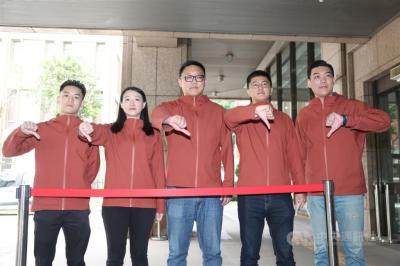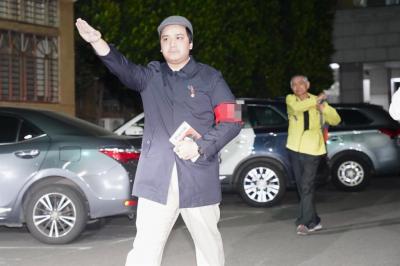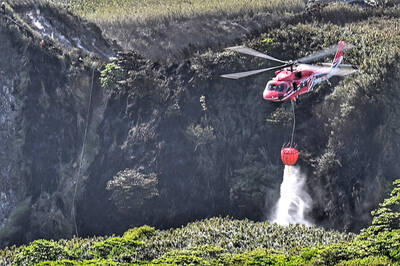Postponing the liftoff of the nation's second satellite, ROCSAT-2, from this month to late next month had no connection to the March 20 presidential election, National Science Council (NSC) officials told legislators yesterday.
The comment came in response to a question from Chinese Nationalist Party (KMT) Legislator Kwan Yuk-noan (
"I wonder why you guys won't have the satellite launched before the election," Kwan said at a meeting held by the legislature's Sci-tech and Information Committee.
KMT Legislator Wang Chung-yu (王鍾渝) called for a report from the council about the delays and possible financial losses they might cause.
"We need details to review R&D [research and development] investments on the project and its future profits," Wang said.
Officials at the National Space Program Office (NSPO) said the launch was adjusted for purely scientific reasons.
According to Lee Lou-chuang (
"So we estimate that the launch could be scheduled between late March and early April. It has nothing to do with the presidential election," Lee said.
ROCSAT-2 was shipped to California on Dec. 1 last year, about six weeks ahead of the original launch date.
On Dec. 10, NSC officials said electrical circuit problems with the Taurus rocket, the launch vehicle, would delay the scheduled liftoff from Jan. 17 to Feb. 26.
Earlier this month, council officials said that US Orbital Sciences Corp (OSC), the operator of the Taurus vehicle, had notified them of inaccuracies in the precision equipment because of the 6.5 magnitude earthquake that shook California on Dec. 22.
OSC requested more time to fix problems with their ground apparatus and the liftoff was delayed to late next month.
Last week, NSC officials and NSPO experts visited the launch site, Vandenberg Air Force Base in California, to probe the cause of the delays. They said most of the problems had been fixed and the satellite was in good condition.
NSC Deputy Minister Shieh Ching-jyh (
Lee said the OSC would have to pay US$36,500 for each day the launch was delayed based on the contract. The count began in the middle of January. Compensation, however, is limited to a maximum of US$3.6 million.
Lee said that US$14.4 million of the total launching fee of US$36 million had not yet been paid to OSC. The delay compensation will be deducted from the unpaid amount and the remainder will not be paid until ROCSAT-2 is successfully launched.

Taiwan is stepping up plans to create self-sufficient supply chains for combat drones and increase foreign orders from the US to counter China’s numerical superiority, a defense official said on Saturday. Commenting on condition of anonymity, the official said the nation’s armed forces are in agreement with US Admiral Samuel Paparo’s assessment that Taiwan’s military must be prepared to turn the nation’s waters into a “hellscape” for the Chinese People’s Liberation Army (PLA). Paparo, the commander of the US Indo-Pacific Command, reiterated the concept during a Congressional hearing in Washington on Wednesday. He first coined the term in a security conference last

Prosecutors today declined to say who was questioned regarding alleged forgery on petitions to recall Democratic Progressive Party (DPP) legislators, after Chinese-language media earlier reported that members of the Chinese Nationalist Party (KMT) Youth League were brought in for questioning. The Ministry of Justice Investigation Bureau confirmed that two people had been questioned, but did not disclose any further information about the ongoing investigation. KMT Youth League members Lee Hsiao-liang (李孝亮) and Liu Szu-yin (劉思吟) — who are leading the effort to recall DPP caucus chief executive Rosalia Wu (吳思瑤) and Legislator Wu Pei-yi (吳沛憶) — both posted on Facebook saying: “I

Sung Chien-liang (宋建樑), who led efforts to recall Democratic Progressive Party (DPP) Legislator Lee Kun-cheng (李坤城), was released on bail of NT$80,000 today amid outcry over his decision to wear a Nazi armband to questioning the night before. Sung arrived at the New Taipei District Prosecutors’ Office for questioning in a recall petition forgery case last night wearing a red armband bearing a swastika, carrying a copy of Adolf Hitler’s Mein Kampf and giving a Nazi salute. Sung left the building at 1:15am without the armband and covering the book with his coat. Lee said today that this is a serious

A mountain blaze that broke out yesterday morning in Yangmingshan National Park was put out after five hours, following multi agency efforts involving dozens of fire trucks and helicopter water drops. The fire might have been sparked by an air quality sensor operated by the National Center for High-Performance Computing, one of the national-level laboratories under the National Applied Research Laboratories, Yangmingshan National Park Headquarters said. The Taipei City Fire Department said the fire, which broke out at about 11am yesterday near the mountainous Xiaoyoukeng (小油坑) Recreation Area was extinguished at 4:32pm. It had initially dispatched 72 personnel in four command vehicles, 16